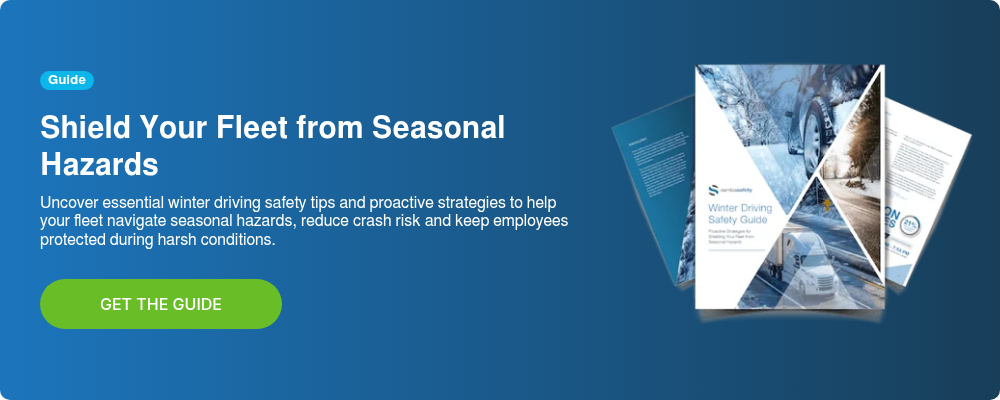
For many, winter and the holiday season mean a reprieve from the hustle and bustle of everyday life. For fleet drivers, winter is especially stressful – with hazardous road conditions, increased traffic, unpredictable weather and increased pressure to meet deadlines safely.
It’s essential that all fleet drivers prepare for seasonal hazards regardless of their location. The Federal Highway Administration (FHA) estimates that nearly 70% of United States roads are in snowy regions, and each year, approximately 117,000 people are injured in winter-weather crashes.
As the year draws to a close, winter safety best practices must be top of mind for your entire organization. Below, we explore five winter driving safety tips for employees that will prepare your workforce for a hectic holiday season.
Download a Week's Worth of Winter Driving Safety Messages to Share with Your Team
5 Must-Share Winter Driving Safety Tips for Employees
1. Pay Careful Attention to Winter Safety Reminders
Fleet drivers should prioritize paying attention to safety messages and reminders sent by their company during the winter season. These messages often contain vital information and guidelines specifically tailored to the unique challenges and hazards of winter driving. Following these recommendations can significantly reduce the risk of crashes, injuries and vehicle damage.
By heeding safety messages, drivers demonstrate their commitment to responsible and safe driving practices, which protects their own well-being and safeguards the reputation and assets of the company.
Employer Tip:
If you’re not sending out repeated reminders – and sending them out early – busy fleet drivers are bound to miss important information. No matter the method, ongoing communication is the key to a safety program that sticks. Consider drafting a messaging schedule to ensure employees receive a steady drip of best practices throughout the holiday season and beyond.
To ensure your winter driving safety strategy has the biggest impact, opt for something simple and actionable. We recommend:
- Hanging a winter injury prevention poster in the break room
- Texting or emailing a quick daily safety message
- Requiring supervisors to share a winter driver safety tip in every driver briefing
- Highlighting relevant winter driving statistics
2. Remember that Safety Starts On-Site
It’s easy to make careless mistakes under a time crunch. That’s why winter safety awareness begins in the warehouse, not on the road. Did you know employees are far more likely to get hurt in a slip, trip and fall incident than in a collision? Employees can prioritize injury prevention by wearing weather-appropriate clothing, inspecting their surroundings for potential hazards and taking their time when entering and exiting their vehicles.
Download and Share Our Free Graphic for Preventing Out-of-Vehicle Incidents
Employer Tip:
When there’s a flurry of activity, mess and clutter can build up quickly. Do your part by keeping walkways clear and dry, shoveling and sanding sidewalks and re-routing traffic as needed.
OSHA-certified training is another great way to prevent needless (and costly) injuries. If you want to protect your team’s safety and bottom line, introduce courses like “Back Injury Prevention” and “Slips, Trips and Falls” to your existing training program.
3. Perform a Pre-Trip Inspection Before Every Journey
During the winter months, crashes and breakdowns are far more common. Drivers must ensure they are fully prepared before setting off on any trip by conducting a throughout pre-trip inspection. This should include:
- Checking fuel levels, lights (headlights, taillights, brake lights, turn signals), electrical systems, antifreeze and windshield wipers
- Clearing ice and snow from lights and reflectors for better visibility
- Ensuring working defrosters and a clutter-free dashboard for proper airflow
- Regularly inspecting exhaust systems to prevent carbon monoxide risks
- Checking tire pressure regularly, as cold weather can cause air loss, affecting traction
- Inspecting tires for damages and tread loss, as even minor issues can escalate on slippery roads
With this proactive approach, drivers will be set to tackle the winter roads with confidence and peace of mind.
Employer Tip:
Take the guesswork out of pre-trip inspections with a detailed checklist. When you outline the specific steps drivers should take before getting behind the wheel, you can ensure both their safety and the long-term performance of your vehicles. Not sure where to begin? Our winter pre-trip inspection checklist outlines everything your drivers should keep in mind.
4. Learn Proactive Strategies for Driving in Snow
An employee’s ability and confidence to drive in snow ensures safer journeys, reduces the risk of crashes and keeps fleets running smoothly – even in adverse conditions. Below are quick tips that can be shared with drivers to help them better navigate these hazardous conditions:
- Slow down and adjust speed for snowy or icy conditions, accounting for lower traction
- Maintain proper distancing by increasing following distance to at least five to six seconds
- Use gentle pressure on gas and brakes to prevent skids and give enough time to slow down for stoplights
- Be strategic on hills by avoiding excessive gas on snow-covered inclines. Instead, build momentum on a flat road before tackling an uphill stretch
- Anticipate road hazards, stay vigilant about other drivers’ actions and be prepared to react calmly to unexpected situations
- Stay focused on the road, avoid mobile device usage and refrain from distractions like adjusting the radio
- Keep the gas tank full to ensure the vehicle can run, provide warmth, prevent condensation and improve traction for lighter vehicles
- Plug in electric/hybrid vehicles at night to maintain optimal battery temperature and minimize self-heating-related battery drain in low temperatures
Employer Tip:
Consider adding repeated, proactive training to your winter safety strategy. Enrolling drivers in winter driving training is an effective and proactive measure that can help ensure employees have the skills, knowledge and confidence needed to navigate snowy winter conditions. Many of the winter driving safety strategies are also applicable year-round. Defensive driver training, which teaches drivers to anticipate problems before they happen, will ensure your fleet stays sharp and observant in any season.
5. Know How to Handle Emergency Situations
Facing winter weather emergencies requires a critical understanding of how to effectively respond. Sharing the following guidelines can help combat dangerous winter conditions that may leave drivers stranded or immobilized:
- Stay with the vehicle for shelter and to remain visible for rescuers
- Enhance visibility with brightly colored items on the antenna or windows
- Keep the interior dome light on at night for better visibility
- Clear exhaust pipes to prevent carbon monoxide leaks
- Avoid overexertion to prevent exhaustion and increased risks
- Stay warm with pre-packed blankets and insulation materials
- Conserve fuel by using the engine and heater sparingly for extended emergencies
Employer Tip:
Pre-trip preparation is only half of the battle. No matter how proactive drivers are, they may still encounter situations they weren’t expecting. All fleet vehicles should include a well-prepared winter emergency kit to ensure the safety and well-being of drivers in unanticipated scenarios. Items can include:
- A first aid kit with basic supplies
- Maps and a compass
- A bright, high-quality flashlight and extra batteries
- Water and non-perishable food
- A shovel and ice scraper
- Traction aids like sand, kitty litter and traction mats
- Tow ropes and straps
- A window breaker and seatbelt cutter
Remember to check these emergency kits periodically to verify that all items are functional, up-to-date and effective.
Looking for More Winter Safety Tips for Employees?
In our guide linked below, our experts share more essential winter driving safety tips for employees that you and your drivers can implement to defend your fleet throughout the winter months and beyond. Download your free copy today!




